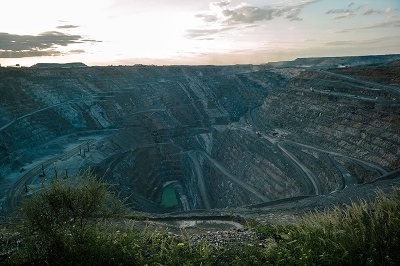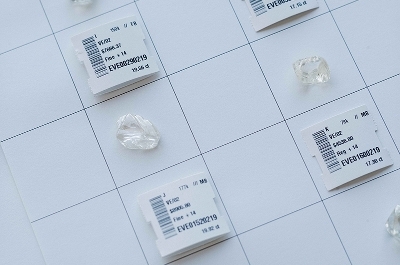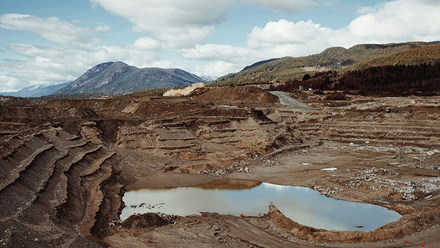Blockchain – a new era for mining supply chains?
As companies operate within more complex business networks it has become difficult to determine the who, what, where, when and why of any product. Ledetta Asfa-Wossen explores the impact blockchain could have on mining.

Eastern Congo, rich in minerals such as coltam, cobalt, tantalum, tin and gold, is probably the most renowned country for conflict minerals. The country has several mining sites known to be controlled by military groups, although this is currently being targeted by various legislations. The most significant of these is the USA’s Dodd Frank Act, signed into law by then-President Barack Obama in 2010. This puts pressure on companies selling products that may contain conflict minerals, requiring them to monitor their mineral supply chains closely to ensure they do not contribute to conflict or human rights violations.
Conflict minerals, as defined by USA legislation, currently include the metals tantalum, tin, tungsten and gold – derivatives of the minerals cassiterite, columbite-tantalite and wolframite. Downstream companies often refer to the derivatives of these minerals as 3TG, and these can be found in anything from smartphones to cars and jewellery.
In the EU, The Conflict Minerals Regulation will come into full effect on 1 January 2021. The directive requires EU companies in the supply chain to ensure they import minerals and metals from responsible and conflict-free sources only and that they adhere to OECD standards. But regardless of these laws, research from International Peace Information Service (IPIS) suggests that corruption still contaminates responsible sourcing initiatives and that effectiveness of traceability is not so clear cut. However, both of the above legislations have come under criticism.
Mining change

In response to issues around sourcing, The World Economic Forum (WEF) has partnered with several mining companies, from Tata Steel to Glencore, in an attempt to design and deploy blockchain solutions for the mining industry, to improve responsible sourcing of raw materials and reporting of carbon emissions. The Mining and Metals Blockchain Initiative includes Antofagasta Minerals, Eurasian Resources Group Sarl, Klockner & Co, Minsur SA and Anglo American/De Beers.
‘Material value chains are undergoing profound change and disruption,’ said WEF Head of the Mining and Metals Industry, Jörgen Sandström. ‘The industry needs to respond to the increasing demands of minerals and materials while responding to increasing demands by consumers, shareholders and regulators for a higher degree of sustainability and traceability of products.’
According to WEF, previously, many blockchain projects to support responsible sourcing have been bilateral. ‘The result has been a fractured system that leaves behind parts of the ecosystem and lacks interoperability,’ it stated, while the new initiative will be owned and driven by the industry. This will allow members to examine issues related to governance and establish a working group with the aim to develop a joint and inclusive blockchain platform.
Last year, Canadian start-up Minehub also launched a supply chain blockchain platform for the mining and metals industry in collaboration with IBM and the likes of ING, Wheaton Precious Metals and Capstone Mining.
Reliable information
‘Blockchain has the ability to revolutionise the mining industry. Distributed ledger technologies have already been implemented within the supply chains of other industries - such as food produce and shipping - and have provided much needed transparency and security,’ explained Blockchain & Climate Institute Research Officer, Stephanie Freeman.
‘As consumer demand shifts, there is a great potential for efficiency and transparency within supply chains. Consumers want to know the source of the products they are buying and are willing to be selective with their purchases. Businesses using distributed ledger technology for supply chain management will have an advantage in the market.’
Across many industries, the typical technology being used in supply chain management is outdated and does not provide a sufficient overview of the supply chain network, argued Freeman.
‘Information is often contained within silos and is not accessible to everyone, generating inefficiencies. Fragmented data is available between parties, therefore verifying the integrity of products is difficult. Blockchain technology can provide a solution to these issues,’ she said. ‘The decentralised nature of the system allows all parties within the supply chain to have an overview of all materials and products from the source to the consumer. Furthermore, as the data held within the blockchain is immutable, it creates a secure and reliable source of information.’
Smart contracts – a computer programme stored in a blockchain that automatically moves digital assets between accounts when conditions encoded in the programme are met – can also be embedded within the blockchain, enabling greater efficiency for supply chain management. ‘For example, a smart contract could be created to counter the movement of material from one stage or party of the supply chain to another with a payment. This enhances efficiencies as parties will receive payments upon the receipt of goods or services,’ said Freeman.
Tracking diamonds
Distributed ledger technology has already been implemented within diamond mining supply chains, Freeman noted. Everledger, a self-branded digital transparency company, provides jewellers with a decentralised ledger to track diamonds – this has already been used by companies such as Brilliant Earth, Fred Meyer Jewellers, USA, and Facet, Europe, where diamonds are traced from their extraction to the consumer.
‘The minerals and mining industry has a number of problems within supply chain management, such as conflict mining, human rights abuses, fraud and illegal, unreported and unregulated activity. A similar process could be applied throughout the industry to help generate standards for promoting transparency and responsibility,’ said Freeman. ‘Moreover, an independent third party could be used to verify all parties within the supply chain, including those extracting the minerals who may be small businesses or local miners in developing countries, to ensure activities are being conducted without violations.’
The most beneficial aspect of using blockchain technology for the minerals and mining industry is that the distributed nature of the technology ensures that no one party or person has control.

‘As consensus is required this reduces the likelihood of fraud and error as this would have to be passed by all those within the network. This aspect makes blockchain secure and particularly useful for supply chain management where authenticity is increasingly important,’ said Freeman.
‘Companies that use 3TG minerals are required to conduct reasonable due diligence and reporting on the origins of such minerals in compliance with the Conflict Minerals Rule (Securities Exchange Act, 1934),’ she added. ‘Use of a blockchain would also provide this information with greater speed and detail, increasing efficiency for those who are part of these mineral supply chains. Start-up Minespider, for example, uses a distributed ledger to verify the authenticity of minerals using certificates which are distributed to mineral suppliers.
Such certificates contain full information on the minerals held by the supplier, required for thorough due diligence.’ Distributed traceability platform Tracr CEO, Jim Duffy, is a member of the WEF consortium and has worked successfully alongside the firm’s developer, De Beers Group’s, various divisions to ensure its diamonds are all sustainably sourced.
‘Blockchain can have an extremely positive impact on the mining industry, especially when used in concert with other technologies such as the Internet of Things, AI and security and privacy,’ said Duffy. ‘At Tracr, this approach has already proven successful to connect the diamond industry at scale. It is enabling these connected companies to substantiate their sustainability stories in a way not previously possible.
‘We can now establish provenance, traceability and authenticity of diamonds, which in turn enhances trust and are able to objectively and confidently demonstrate that diamonds are sustainably sourced. The Tracr Connected Industry Platform was built in collaboration with the diamond industry, and the WEF Mining and Metals Blockchain Initiative is another opportunity for industry collaboration we are excited to be a part of.’
The blockchain company has also collaborated with De Beers Group Industry Services to create a third-party verification process for their grading certificates.
‘This is the first time a grading certificate has been made a digital asset and linked to its diamond digital asset counterpart,’ added Duffy. ‘Tracr’s documentation validation makes swapping a certificate with a diamond exponentially harder, eliminating fraud. Tracr is also interoperating with other traceability initiatives and we are looking to marry Tracr-verified diamonds with Trustchain – the gold traceability platform developed by Richline – to mirror the way diamonds meet other materials in the physical world.’
Potential for the energy sector
World Energy Council former CEO, Emerald Technology Ventures partner, Energy Web Foundation and EPFL advisor, Christoph W Frei,
also sees potential for blockchain in the energy sector. The WEF alone has identified 65 additional uses for the technology in addressing urgent environmental challenges.
‘Blockchain has a potentially great positive impact as it enables automation of large numbers of small transactions at low transaction costs. This is relevant in the context of platform/aggregator business models, renewables or CO2 certificates and trading of small renewable production,’ said Frei.
But is there enough understanding of what blockchain really is within the mining and energy industry for it to become a widespread supply chain solution anytime soon? Frei thinks so.
‘Understanding has matured in a peer group of leading companies in the industry and a number of them such as Singapore Power, Engie, Shell and PTT are all moving to the implementation of applications. A first application that is already in use is renewable energy certificates, developed by the Energy Web Foundation and used by Singapore Power Corp and others,’ he added. ‘The trade of small distributed typically renewable energy is being piloted in a number of places. Aggregation of already existing storage and load-shifting units in the system into useful volumes for the system operator is another application, but further out as it requires relevant hardware to be upgraded with relevant connectivity and intelligence.’
Changing perceptions
Freeman, however, noted that there is still more awareness needed about blockchain’s potential and application in the energy industry, and that some companies may hold reservations over its use.
‘I think blockchain is still generally more associated with cryptocurrencies, in particular bitcoin,’ she said. ‘Therefore, there may be some apprehension in using this technology for other business purposes when many still view it as being closely linked to an instrument exhibiting such high volatility. It could be perceived as a “risky” technology by some. However, there are a growing number of start-ups now using distributed ledger technologies for a range of other activities.’
A greater understanding of this technology for the energy industry and its adaptability may well come to fruition as further companies begin to garner more interest and publicity.
‘A number of fintech hubs have sprung up across Europe. Many of the start-ups in this space use distributed ledger technologies, so Europe is already quite far ahead in the implementation of this technology and its applications,’ said Freeman. ‘Furthermore, developing economies may benefit heavily from such companies as blockchain networks tend to remove the dependency on the intermediary – e.g. a bank or energy provider – which enables greater accessibility to individuals.’







